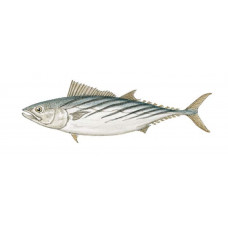Latin name
Sarda chiliensis
Other names
California bonito, eastern Pacific bonito, bonehead, Laguna tuna, striped tuna, ocean bonito; French: bonite du Pacifique; Japanese: hagatsuo; Spanish: bonito del Pacífico.
Identification
It is similar in size and coloration to the Atlantic bonito. The Pacific bonito differs from most others in having no teeth on its tongue and a straight intestine without a crease in the middle. It has 17 to 19 spines on its first dorsal fin and is the only tunnel-like fish on the California coast that has an oblique dark band on its back. The body is cigar-shaped and somewhat compressed, with a pointed and conical head and a large mouth. It is dark blue on top and silvery on the sides below.
Distribution
Pacific bonito occur intermittently from Chile to the Gulf of Alaska. They are most abundant in the Northern Hemisphere in warm waters between Magdalena Bay, Baja California, and Point Conception, California.
Habitat
Bonito inhabit the surface and intermediate depths of the open sea and are migratory fish. Adults usually live farther from the coast than juveniles. May arrive off the coast in spring when warming ocean waters arrive, may not appear at all if ocean conditions are colder than normal temperatures.
Size
The maximum length from the beginning of the snout to the fork of the caudal fin in the Southern Hemisphere is 79 cm, and in the Northern - 102 cm, weight 11.3 kg.
Life history and Behavior
Spawning occurs sometime between September and February. It is successful every year in the southern part of their range, in more northern areas it may not be successful every year. Free-floating eggs take about 3 days to hatch at average water temperatures. Males and females reach sexual maturity at about two years of age. The length to the fork of the tail of the smallest mature Chilean pelamids ranges from 47-53 cm. Fertility is directly related to size. Maximum life span of about 6 years. The generation length is estimated at 3-4 years.
Food and feeding habits
Pelamidae are predators. The main diet consists of small gregarious pelagic fish, the type of which depends on the geographical habitat. They also hunt squid and shrimp. Cannibalism is common.
Reproduction
They reproduce by spawning. The eggs are pelagic with several fat droplets, with an egg diameter of 1.3 mm. In the southern hemisphere, spawning occurs in coastal waters from September to December, while in the northern hemisphere it begins in early March and continues until May. Egg throwing occurs in several batches. The fecundity is about 0.5 million eggs in fish weighing about 3 kg.
| Classification | |
| Phylum | Chordata |
| Class | Actinopterygii |
| Squad | Scombriformes |
| Family | Scombridae |
| Genus | Sarda chiliensis |
| Species | S. chiliensis |
| Features | |
| Conservation status | No information |
| Habitat | Pelagic |
| Life span, years | 5 |
| Maximum body weight, kg | 9 |
| Maximum length, cm | 150 |
| Sailing speed, m/s | 27 |
| Threat to people | Edible |
| Way of eating | predator |



